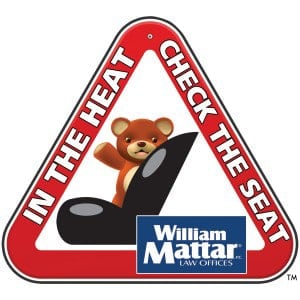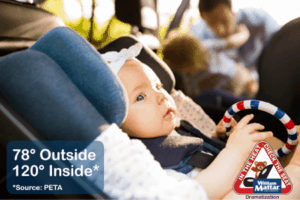In the Heat, Check the Seat

In 2015, William Mattar law offices launched In the Heat, Check the Seat to raise awareness of heatstroke-related injuries children and animals experience because of being left in hot motor vehicles. Since the campaign’s inception, car accident attorney William Mattar has worked to remind parents and caregivers in the community to always check the backseat for children and pets before exiting a car. Leaving a child or pet in your vehicle on a hot day can be deadly. Checking the seat could prevent a tragedy.
A simple reminder may save a precious life. Together we can help keep our children and pets safe this summer.

Tips to Keep Your Children and Pets Safe This Summer:
- Make sure all children and pets have exited the car after you arrive at your destination. As a reminder to check before leaving your motor vehicle, place an item you will need in the back seat, such as a wallet, purse, or cell phone.
- Do not leave an infant in a car just because they are asleep.
- Before securing your child in a car seat, always check that the surfaces and safety buckles are not too hot. In high temperatures, metal and plastic material can heat up enough to burn your child’s skin.
- Never leave a child unattended in a motor vehicle, even if it is not a hot day. They could unintentionally put the vehicle in gear, causing it to move or roll forward.
- Make sure always to lock your car and keep the keys out of your child’s reach. They could potentially lock themselves in the trunk or hurt themselves or others by playing in or around a vehicle.
- Call 911 if you see a child alone in a car. Emergency personnel are professionally trained to handle these situations and want you to contact them first.
What is Heatstroke?
Heatstroke is a condition that occurs when a person’s body overheats due to prolonged exposure to, or physical exertion, in high temperatures and is most common during the summer months. A person suffering from heatstroke requires emergency treatment. If treatment is prolonged, there may be a higher risk of serious complications or death. If left untreated, heatstroke can damage your heart, muscles, brain, and kidneys. When a person’s body temperature reaches 104 F or higher, the most serious form of heatstroke injury can occur.
Heatstroke Injury Facts:
According to the National Safety Council and Safe Kids Worldwide:
- Each year on average, 38 children under the age of 15 die from heatstroke after being left in a hot car.
- In 2020, there were 25 child hot car deaths alone.
- With an outside temperature of 72 F, the internal vehicle temperature can reach 117 F within 60 minutes. Approximately 80 percent of a vehicle’s interior temperature increase happens within the first 30 minutes.
- Young children are at a higher risk, as their bodies heat up to three to five times faster than adults.
- Cracking a window does not help to lower the car’s internal temperature. Children and small, short-snouted dogs cannot reach the ventilation intended to help them.
- For dog owners, brachycephalic (or short-snouted) dog breeds, such as boxers, pugs, bulldogs, etc., are more vulnerable to heatstroke.
Heatstroke Symptoms
According to the Mayo Clinic, signs and symptoms of heatstroke in people include:
- A throbbing headache;
- Nausea and/or vomiting;
- A change in your sweat. If heatstroke is caused by vigorous exercise, your skin may feel dry or slightly moist. If heatstroke is caused by hot weather, your skin may feel hot and dry to the touch;
- The main sign is a core body temperature of 104 F or higher;
- Your skin may turn red or become flushed as your body temperature increases;
- Heat stress may cause your heart to race and your pulse to increase to help cool down your body;
- Heatstroke may cause a person to suffer from slurred speech, confusion, seizures, agitation, coma, irritability, or delirium;
- It may cause your breathing to become rapid and shallow.
If you or a loved one is exhibiting any of the above heatstroke symptoms, contact 911 or seek immediate medical attention. While waiting for emergency services to arrive, the Mayo Clinic suggests beginning to help the overheated person cooldown by:
- Removing additional clothing;
- Getting the person into the shade or indoors;
- Cooling the person down, however possible; spray them with a garden hose, place a cold, wet towel or ice packs on the person’s neck, armpits, head, and groin, put them into a cool shower or tub of water, fan while misting with cool water, or sponge with cool water.
Don’t forget your furry friends! Symptoms of heatstroke in animals such as dogs may include:
- Drooling or salivating;
- Excessive panting or difficulty breathing;
- Agitation and restlessness;
- Weakness;
- Vomiting; and
- Seizures.
The best way to help your pets is to never leave them in a vehicle, even for a short amount of time. Even on a moderately warm day, a vehicle’s interior temperature can become dangerously high.

















